Cangarda, the touchscreen steam yacht
 Camden Harbor is pretty quiet these days, but on Monday afternoon — while I was stripping electronics off Gizmo prior to her inevitable haul-out — Cangarda, the only existing U.S.-built steam yacht, suddenly slipped around the corner and silently maneuvered onto the Wayfarer dock just ahead of me. Yesterday I was further thrilled when Capt. Steve Cobb himself showed me around, paying special attention to his beloved engine room, where he’d fired up the boiler in order to check that the “water chemistry” was proper for lay up. You see, I already knew a fair bit about Cangarda, though I’d never seen the 126 foot vessel in all her awesome flesh before…
Camden Harbor is pretty quiet these days, but on Monday afternoon — while I was stripping electronics off Gizmo prior to her inevitable haul-out — Cangarda, the only existing U.S.-built steam yacht, suddenly slipped around the corner and silently maneuvered onto the Wayfarer dock just ahead of me. Yesterday I was further thrilled when Capt. Steve Cobb himself showed me around, paying special attention to his beloved engine room, where he’d fired up the boiler in order to check that the “water chemistry” was proper for lay up. You see, I already knew a fair bit about Cangarda, though I’d never seen the 126 foot vessel in all her awesome flesh before…
In fact, when I wrote about Cangarda in 2003, largely with Cobb’s help, she was just an empty worn-out hull, a warehouse of dusty parts, and a gleam in his eye. But the story sort of worked out as hoped, as you can read in part at Wikipedia. Bob McNeil bought the “kit,” shipped it all to Rutherford’s Boatshop (lots of good photos), and for years Cobb spent long periods in California helping to execute what might be called a hybrid restoration. Because McNeil wanted to actually cruise Cangarda is a semi-practical manner, he switched her coal-fired boiler to an automated diesel-fired system. Which is why you see the incredible juxaposition below of a 1901 triple expansion steam engine — that runs now like it did then — alongside an elaborate touchscreen boiler control system. And no worries about that scary-looking slate and knife-switch electrical panel; it’s purely decorative as the yacht now has up-to-code wiring and two diesel generators (tucked in where the coal bins used to be)…
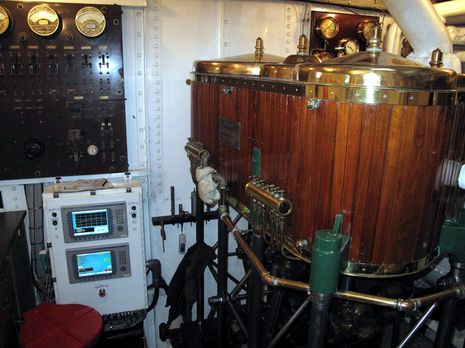 But as useful as those screens may be, like the trend graph below, Capt. Cobb made it clear that the boiler can be operated without the automation (which was engineered by Innovative Control Solutions). He even showed me the very long “match” he’s uses to test his ability to fire up the furnace manually. And he also demonstrated his preferred manner of operating the main engine…
But as useful as those screens may be, like the trend graph below, Capt. Cobb made it clear that the boiler can be operated without the automation (which was engineered by Innovative Control Solutions). He even showed me the very long “match” he’s uses to test his ability to fire up the furnace manually. And he also demonstrated his preferred manner of operating the main engine…
 In the photo below, Steve’s right hand is on the shift lever that’s directly attached to the ingenious reversing mechanism (apparently designed, at least in part, by Nathanael Herrshoff) and to the left of his head is the throttle that’s directly attached to the large insulated steam valve. The brass bell system is, of course, how the bridge crew communicate their shift and throttle desires. The modern Cangarda does have remotely switched hydraulic actuators for both controls, but Steve was standing right here when they came into Camden, while his able mate did the driving. Heck, besides being able to mother the machinery, from here he can control propulsion to a docking exactitude like “reverse five turns” — easy to count when you’re looking at a huge exposed crank shaft on an engine whose RPMs only range from 15 to about 200!
In the photo below, Steve’s right hand is on the shift lever that’s directly attached to the ingenious reversing mechanism (apparently designed, at least in part, by Nathanael Herrshoff) and to the left of his head is the throttle that’s directly attached to the large insulated steam valve. The brass bell system is, of course, how the bridge crew communicate their shift and throttle desires. The modern Cangarda does have remotely switched hydraulic actuators for both controls, but Steve was standing right here when they came into Camden, while his able mate did the driving. Heck, besides being able to mother the machinery, from here he can control propulsion to a docking exactitude like “reverse five turns” — easy to count when you’re looking at a huge exposed crank shaft on an engine whose RPMs only range from 15 to about 200!
 Below is a starboard view of that crank, which connects directly to a 65 foot shaft and a five-foot, five-bladed prop. Behind it you can make out the secondary shaft used for shifting, and in several places you can also see the copper pipes used to drip oil into critical bearings from the manifolds seen a few photos up attached to the wooden cover around the pistons (which vary in size from 9 inches to 24, as explained in my original article). Some oiling is meant to be done by hand, however…
Below is a starboard view of that crank, which connects directly to a 65 foot shaft and a five-foot, five-bladed prop. Behind it you can make out the secondary shaft used for shifting, and in several places you can also see the copper pipes used to drip oil into critical bearings from the manifolds seen a few photos up attached to the wooden cover around the pistons (which vary in size from 9 inches to 24, as explained in my original article). Some oiling is meant to be done by hand, however…
 In the shifting shaft closeup below you can see a couple of oil cups…that are filled with hair, horse hair to be specific, which is apparently a traditional and effective way to both filter out grit and to encourage a squirt of oil to enter the bearing at a judicious rate. (The water splashes, by the way, are there because the cylinders had just been purged as part of the boiler shut down procedure.) Steve’s expertise, and passion, about all this sort of detail is infectious, and I do hope to one day see the big engine in action. In the meantime, I did get to experience a couple of Cangarda’s smaller steam motors…
In the shifting shaft closeup below you can see a couple of oil cups…that are filled with hair, horse hair to be specific, which is apparently a traditional and effective way to both filter out grit and to encourage a squirt of oil to enter the bearing at a judicious rate. (The water splashes, by the way, are there because the cylinders had just been purged as part of the boiler shut down procedure.) Steve’s expertise, and passion, about all this sort of detail is infectious, and I do hope to one day see the big engine in action. In the meantime, I did get to experience a couple of Cangarda’s smaller steam motors…
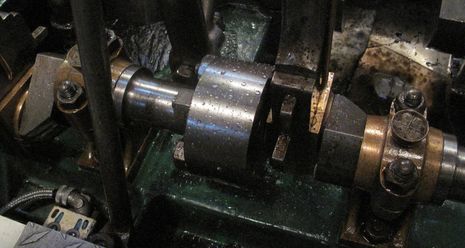 The little steam-powered pump below was quietly chugging away the whole time I was in Cangarda’s engine room — pulling water out of the condenser and back into the boiler, if I recall correctly — and it gave me a sense of how pleasantly different steam is from internal combustion. And how fascinatingly exposed and complex the whole rig is. I wondered, in fact, if the restored Cangarda — which voyaged from San Francisco to Mexico and then from Ft. Lauderdale to New England since last April (the middle passage was the deck of a ship) — has ever operated without Steve on board. The answer is “nope.”
The little steam-powered pump below was quietly chugging away the whole time I was in Cangarda’s engine room — pulling water out of the condenser and back into the boiler, if I recall correctly — and it gave me a sense of how pleasantly different steam is from internal combustion. And how fascinatingly exposed and complex the whole rig is. I wondered, in fact, if the restored Cangarda — which voyaged from San Francisco to Mexico and then from Ft. Lauderdale to New England since last April (the middle passage was the deck of a ship) — has ever operated without Steve on board. The answer is “nope.”
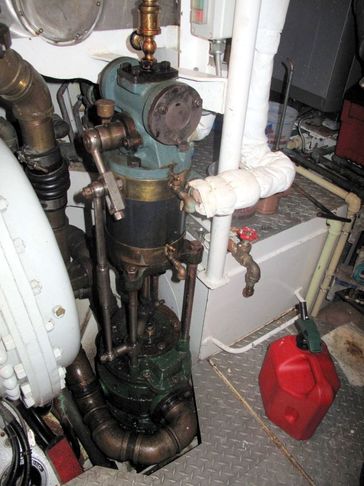 Those long passages were no doubt easier because in addition to the open bridge you can see in the historic photos, Cangarda now has a modest pilothouse fit into the forward end of what used to be simply a dining salon. There wasn’t room for another wheel, so steering is done with a little jog stick when the Raymarine autopilot isn’t taking care of it. This is about all you may see of electronics on the yacht — aside from one more boiler control screen discretely mounted on the bridge — because the radar dome as well as an Iridium OpenPort sat coms dome are used on removable mounts. And she does look striking…
Those long passages were no doubt easier because in addition to the open bridge you can see in the historic photos, Cangarda now has a modest pilothouse fit into the forward end of what used to be simply a dining salon. There wasn’t room for another wheel, so steering is done with a little jog stick when the Raymarine autopilot isn’t taking care of it. This is about all you may see of electronics on the yacht — aside from one more boiler control screen discretely mounted on the bridge — because the radar dome as well as an Iridium OpenPort sat coms dome are used on removable mounts. And she does look striking…
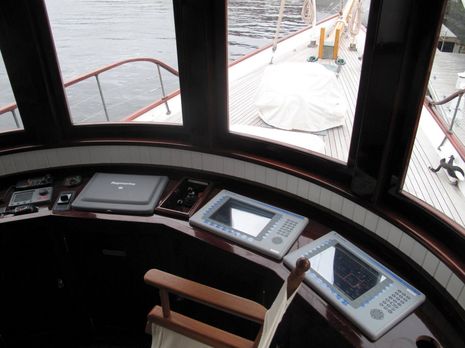 The photo taken from Gizmo below doesn’t do her real justice, but you can detect a whiff of smoke from the boiler, and that is one of Capt. Cobb’s former rides shrink wrapped at the left — he was owner and master of the schooner Mary Day for several years. I’m really glad he’s back in the harbor, at least for this winter, and what a yacht he brought with him.
The photo taken from Gizmo below doesn’t do her real justice, but you can detect a whiff of smoke from the boiler, and that is one of Capt. Cobb’s former rides shrink wrapped at the left — he was owner and master of the schooner Mary Day for several years. I’m really glad he’s back in the harbor, at least for this winter, and what a yacht he brought with him.
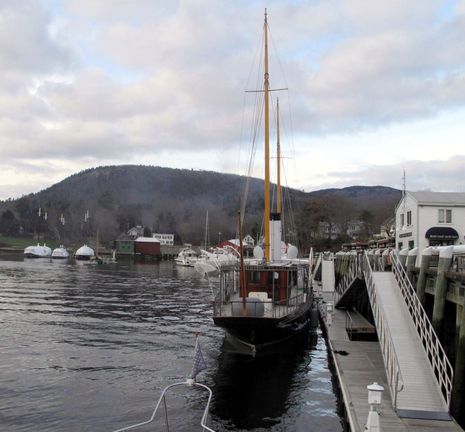
PS Thanks to Tom Babbitt of East Coast Yacht Sales, here’s a great shot of Cangarda steaming by Gizmo on Monday, with the mate on the wheel and engine telegraph. See what I mean by an open bridge! Note that my hand is just visible at left, and if the frame was wider I dare guess my mouth was open. Shortly thereafter, I did scurry down to the bow, but Cangarda slipped by with maybe a foot to spare, which was darn impressive, especially given that the yacht’s stern is about 90 feet aft of the bridge.



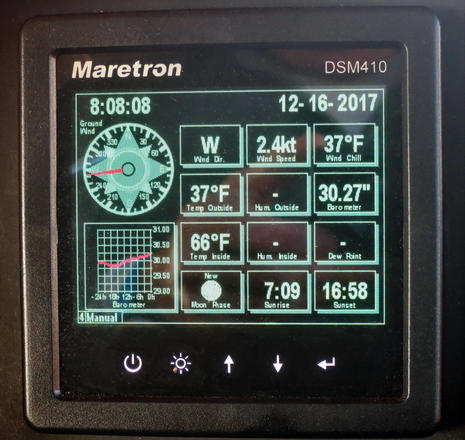










wow! what a beauty!
-mo
There is at least one other steam yacht, “Mascot” built by William Holland of D’Iberville Mississippi for private owners in Louisiana.
It was heavily damaged in Katrina and has been restored to beautiful condition. It similarly has computerized systems to run an antique steam engine drive.
The owners are steam fans and have a Navy Admirals launch they plan to restore next.
Will
When Steve D. of Passagemaker fame surveyed our boat he recommended to me the book The Sand Pebbles, which combines detailed passages about the care and feeding of a 1930s marine steam power plant with China-on-the-verge-of-revolution adventure. It was great fun.
What fun Ben, I am truly envious. I would love to see another view from you while the vessel is underway in the spring.
Wow…this is just about the coolest thing ever. How long is the boat in Camden? At Wayfarer or Yachting Solutions?
Cangarda will spend the winter inside a big shed at Wayfarer Marine, and I’ll surely be lobbying for a ride next Spring 😉
By the way, this is not only classic yacht that Bob McNeil has restored. Check out the 1911, 58′ Herreshoff P-Class racing sloop Joyant, also overhauled (to say the least) at Rutherford’s in California. She has no engine, which is brave, and now races in New England, sometimes with Cangarda as mother ship:
http://rutherfordsboatshop.com/completed.html
McNeil and Rutherford are also involved in restoring the 1885, 133′ schooner yacht Coronet on the IYRS campus in Newport, RI:
http://www.iyrs.org/AboutUs/Projects/CoronetRestoration/tabid/522/Default.aspx
Thanks for keeping these boats alive, Bob!
Thanks, Adam. Since I’m also inclined to take advice from Steve D’Antonio, I checked out The Sand Pebbles at Amazon and found a nice surprise. For some reason the Kindle edition (which can also be read fine on an iPad, iPhone, or Android device) is only $4. No brainer!
http://www.amazon.com/Sand-Pebbles-Bluejacket-Books/dp/1557504466/ref=sr_1_1?s=books&ie=UTF8&qid=1291292138&sr=1-1
There’s some interesting Cangarda material — including Bob McNeil’s log of the first long ocean leg — on a great blog written by Andy Davis, who served as naval architect for the restoration:
http://www.tallshipdesigner.blogspot.com/
McNeil, incidentally, calls her “the last American Edwardian steam yacht” as opposed to Wikipedia’s “last surviving US-built steam yacht in the US, and one of only three left in the world.”
Wow, just realized that Andy Davis’s company, Tri-Coastal Marine, has a superb section on Cangarda, both history and restoration:
http://www.tricoastal.com/Cangarda/Cangarda.html
Ben, I think it’s out of copyright. I’m sure you’ll like it. While some of the technical bits escaped me, it’s well-written and I understood the key “fix” (you’ll see).
Definitely more accessible than the Patrick O’Brian books. I’ve read all 21 of them thrice and I still don’t know what cross-catharpins, Bentinck shrouds, or a dumb-chalder is.
Hi Bill, Have a look at this website, it has some great shots of Cangarda in a race with Medea, another steamyacht.
http://www.printroom.com/ViewGallery.asp?userid=limeydal&gallery_id=2066331
If you are interested in following such things, some discussion of the Cangarda restoration was also reported in the Classic Yacht Symposium proceedings published by the Herreshoff Museum in Bristol, RI.
Ben. Thanks for a fine article.
It seems that every rare or historic vessel has some sort of superlative attached to it: oldest, most original, last etc. Cangarda is no exception. Here’s an explanation.
Of the 600 (perhaps twice that) steam yachts built in America and Great Britain during the ‘Gilded Age’ (1880-1914), only a precious few (3) still exist. Cangarda is the only remaining American built example.
Cangarda, Medea and Ena are of a type: steam powered, tall stack, clipper bow, long counter stern and narrow beam with a vestigial sailing rig. There are a few others of that type in existence but they were built later and are much larger: Nahlin, Savarona, and Haida come to mind but all are diesel. Delphine is still steam but looks nothing like the others; a much more “modern” design.
It has been said (by them what knows) that the classic steam yachts were the ultimate reach of marine design and engineering; the perfect combination of art and science and the most beautiful power yachts ever built. spc
Humorous aside: Where Steve and I live, we get to share the Bays with not only the “the oldest active commercial schooner in the United States”:
http://schoonerfrench.com/
but also “the oldest documented sailing vessel in continuous service in the United States”:
http://www.stephentaber.com/history.html
Both were built in 1871, and both are great operations today.
Nice yacht – well done Steve.
But like the first post says, there are more than 3 steam yachts left.
Carola in Scotland:
http://www.nationalhistoricships.org.uk/ships_register.php?action=ship&id=9
It is worth looking up
http://www.steamyachtthordis.co.uk/
She was built by Camper and Nicholson in 1909 as a steam yacht, then converted.
She is being painstakingly restored in Sharpness, England
She has the most beautiful straight stem and counter stern
Ben,
I was a deckhand on the Vernon Langille with Katy Green and Steve Bailey on your first voyage as skipper. I was a volunteer at the Apprenticeshop in summer of 1982, the kid from California! I left and went Oyster Dredging with Ed Farley and Gino Scalzo.
In the spring of 2009 I got a service call to help start up the oil burners on Cangarda. They were built by a former employer and the model was my specialty. Steve was and Bob were glad I showed up because I was the first person to really make the burners operate with a clear stack and no flame outs. I helped them straighten out quite a few combustion related problems, set up the burners so the touch screen could control them, made the fist sea trails, took the boat to LA and helped race against Madea.
Lots of good memories of it all. Glad to see you involved and have the opportunity to connect.
Eugene Porter, Tiburon, CA
Small world, Eugene, and so glad you came by!
Steve Cobb is no longer on Cangarda, and I’ve heard the vessel has been laid up with mechanical issues quite a bit, but Steve is now running the beautiful Atlantide:
http://www.charterworld.com/news/newly-refitted-122-classic-motor-yacht-atlantide-leaves-front-street-shipyard
Of course he wishes she were steam but he’s excited about possible voyages of exploration, perhaps as far as the Med.
Meanwhile, the Vernon Langille is back in the area and was using my mooring float when we went cruising in July. She has an engine now but here are recent photos showing how she still sails:
http://forum.woodenboat.com/showthread.php?152219-A-nice-bit-of-sailing-in-a-Pinky-Schooner
For the unfamiliar the Langille is fine-ended 35-foot Tancook Schooner that is almost entirely open and was originally built without an engine but with amazing Egyptian Cotton sails, including a killer club-footed fore topsail.
When I started running her with Eugene and other Apprentices the seamanship training program was to sail/row about a cord and half of firewood that we’d piled into the midships area from Bath to Monhegan. That meant dealing either with the capricious winds and whirling currents of the Kennebec River OR the even more capricious winds and whirling tides the Sasanoa/Sheepscot shortcut.
I think we charged about $150 for the firewood hand delivered up onto the pier, though the round trip sometimes took four days or so. It was one of the most ridiculous and challenging things I’ve ever done in a boat, and most of the time it was wicked fun.
The Vernon Langille could sometimes pass similar size modern sailboats, even on the wind, and could maneuver almost as well as a spade rudder boat, though four strong people on big oars could only make about 3 knots max in a calm. I ran the boat for several seasons, and she’s what got me involved in WoodenBoat School as they leased her after the A-Shop went through some hard times. She’s been sunk twice, the first time rather famously (there was a damn photo boat right behind her), but she’s kept on keepin on:
http://news.google.com/newspapers?nid=1499&dat=19810709&id=RAgqAAAAIBAJ&sjid=xCkEAAAAIBAJ&pg=5223,4240866
Sad to report that the amazing yacht Cangarda recently left Maine waters to become a museum exhibit in… wait for it… Turkey:
https://youtu.be/3aZ3Y-IUjqs?si=hWlY3YPuiZgg2phl